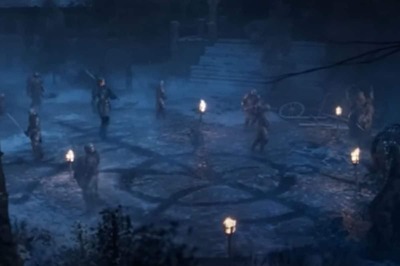
views
Even as Delhi-NCR continued to witness maximum temperatures hovering between 39-41.2 degrees Celsius while Chandrapur in Maharashtra topped with maximum temperature of 44.2 degrees Celsius, the India Meteorological Department (IMD) has said the heat wave spell is likely to continue over Central and West India during next 4-5 days.
For the plains, a “heatwave” is declared when the maximum temperature is over 40 degrees Celsius and at least 4.5 notches above normal. A “severe” heatwave is declared if the departure from normal temperature is more than 6.4 notches, according to the IMD.
Safdarjung, Delhi’s base station, recorded 39.6 degrees Celsius, the IMD said, and predicted maximum temperature to be 40 degrees Celsius on Thursday and Friday both. In similar range, Palam Observatory recorded maximum temperature of 39.6 degrees Celsius, Lodhi Road (40.1), Ridge (40.9), Ayanagar (40.3), Jafarpur (40.0), Najafgarh (40.6), Narela (41.7), Pitampura (41.4), Sports Complex, Dwarka (41.5) and Mayur Vihar recorded 38.4 degrees Celsius while Gurgaon (40.8), Noida (39.4) too, saw maximum temperature in the similar range.
Heat wave to severe heat wave conditions were observed in most parts of West Rajasthan, in many parts of Himachal Pradesh and in some parts of Haryana while heat wave conditions were observed in some parts of East Rajasthan, Madhya Pradesh and isolated pockets of Jammu Division and Uttar Pradesh.
Chandrapur in Maharashtra recorded the highest maximum temperature across India at 44.2 degrees Celsius, followed by Akola (Maharashtra) at 43.2 degrees Celsius.
Multiple places across India that recorded temperatures above 41 degrees Celsius: Gujarat — Rajkot (41.3), Amreli (41.5), Bhuj (41.8) and Surendra Nagar (41.3); Maharashtra — Amaravati (41.8), Washim (42.5), Wardha (42.8), Nagpur (42.1), Brahmapuri (41.8) and Gondia (41.5), Malegaon (41.0), Solapur (42.8); Rajasthan — Ganganagar (41.3), Churu (43), Bikaner (42.5), Jaisalmer (41.8), Barmer (42.7), Jodhpur (41.2), Pilani (42.8) and Kota (41.6); Madhya Pradesh – Ratlam (41.8), Gwalior (41.7), Rajgarh (42.0), Khandwa (42.1), Khargone (42.4), Dhar (41.2), Khajuraho (42.4), Damoh (41.8) and Satna (41.2) degrees Celsius, the IMD data showed.
Heat wave to severe heat wave conditions in most parts are very likely to continue over in many parts on March 31 and in some parts over West Uttar Pradesh, East Rajasthan & West Madhya Pradesh on March 31. Heat wave to severe heat wave conditions in isolated pockets over south Haryana & Delhi on March 31.
“It is likely to reduce spatially and in terms of intensity over these areas during April 1-3 with heat wave conditions in some pockets over these areas during the same period,” the IMD forecast added.
Farmer Dies of Heatstroke in Maharashtra
A 27-year-old farmer died of heat stroke in Maharashtra’s Jalgaon district, as parts of the state continue to witness heatwave conditions, officials said on Wednesday. An official at the Jalgaon district collectorate claimed this was probably the first such case during the current summer season in the state.
On Tuesday, Jalgaon district, located over 400 km from Mumbai, recorded a maximum temperature of 41.8 degrees Celsius, which was 2.5 degrees C higher than normal, as per a report of the India Meteorological Department (IMD).
The farmer, Jitendra Sanjay Mali, was on Tuesday afternoon rushed by some people to the Amalner rural hospital in Jalgaon where he was declared dead on arrival, Dr Ashish Patil from the medical facility said. Prima facie, Mali died of heat stroke. He was working in a farm and while going back home, he fainted during the scorching heat. The other farmers working nearby rushed him to the hospital, but we could not save him, Dr Patil said.
IMD Asks People to Avoid Sun Exposure; Labour, Fire Depts Alerted
Meanwhile, the IMD has asked people to avoid sun exposure as much as possible. The Labour ministry, Power ministry, Fire departments have also been alerted of the heatwave.
Delhi Boils
Parts of Delhi have been sweltering under a severe heatwave with the maximum temperature crossing the 41-degree mark at three places on Wednesday, the India Meteorological Department said.
IMD officials said a prolonged dry spell has led to “severe” hot weather conditions in northwest India. “The heatwave spell over northwest, central and west India is likely to continue for the next four to five days.”
Eight weather stations in Delhi recorded their maximum temperature above 40 degrees Celsius. The mercury settled at 41.7 degrees Celsius, 41.4 degrees Celsius and 41.5 degrees Celsius at Narela, Pitampura and Sports Complex stations respectively. The Safdarjung observatory, considered the official marker for the city, recorded a high of 39.6 degrees Celsius — eight notches above normal.
Another spell of heatwave in Delhi is likely from April 3 to April 5, the IMD officials said.
According to non-profit green think tank Climate Trends, maximum temperatures in the second half of March have witnessed a rise over the last three years.
The capital had recorded a maximum temperature of 40.1 degrees Celsius on March 30 last year. The all-time highest maximum temperature in this month (40.6 degrees Celsius) was recorded on March 31, 1945. “The absence of a weather system and the presence of an anti-cyclone over Rajasthan and adjoining Pakistan have been pushing hot winds across North and Central India. March is going to end on a hotter note with no respite till the beginning of April,” said Mahesh Palawat, vice president, Meteorology and Climate Change, Skymet Weather.
With inputs from PTI, IANS
Read all the Latest News India and Breaking News here

















Comments
0 comment